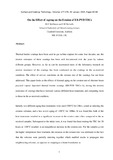JavaScript is disabled for your browser. Some features of this site may not work without it.
| dc.contributor.author | Wellman, R. G. | - |
| dc.contributor.author | Nicholls, John R. | - |
| dc.date.accessioned | 2011-02-07T23:12:34Z | |
| dc.date.available | 2011-02-07T23:12:34Z | |
| dc.date.issued | 2004-01-30T00:00:00Z | - |
| dc.identifier.citation | R. G. Wellman and J. R. Nicholls, On the effect of ageing on the erosion of EB-PVD TBCs, Surface and Coatings Technology, Volumes 177-178, 30 January 2004, Pages 80-88. | en_UK |
| dc.identifier.issn | 0257-8972 | - |
| dc.identifier.uri | http://dx.doi.org/10.1016/j.surfcoat.2003.06.019 | - |
| dc.identifier.uri | http://dspace.lib.cranfield.ac.uk/handle/1826/753 | |
| dc.description.abstract | Thermal barrier coatings have been used in gas turbine engines for some four decades, and the erosion resistance of these coatings has been well documented over the years by various different groups. However, as far as can be ascertained most of the laboratory research on erosion resistance of the coatings has been conducted on the coatings in the as-received condition. The effect of service conditions on the erosion rate of the coatings has not been addressed. This paper looks at the effects of thermal aging on the erosion rate of electron beam physical vapour deposited thermal barrier coatings (EB-PVD TBCs) by testing the erosion resistance of coatings that have received various different heat treatments and comparing them to those in the as received condition. Initially two different aging heat treatments were used 1500à °C for 24hrs, aimed at sintering the ceramic columns, and a less severe aging of 1100à °C for 100hrs. It was found that both of the heat treatments resulted in a significant increase in the erosion rates when compared to the as received samples. Subsequent to the initial tests, it was found that heat treating the TBC for 30 hours at 1100à °C resulted in an insignificant increase in the erosion rate. For the samples given the higher temperature heat treatment, the increase in the erosion rate was attributed to the fact that the columns were partially sintering together which enabled cracks to propagate into neighbouring columns, as opposed to stopping at column boundaries as occurs in samples that have not been heat treated. This results in an increase in erosion rate due to the fact that more material is removed per impact eve | en_UK |
| dc.language.iso | en_UK | en_UK |
| dc.publisher | Elsevier Science B.V., Amsterdam. | en_UK |
| dc.rights | NOTICE: this is the author’s version of a work that was accepted for publication in Surface and Coatings Technology. Changes resulting from the publishing process, such as peer review, editing, corrections, structural formatting, and other quality control mechanisms may not be reflected in this document. Changes may have been made to this work since it was submitted for publication. A definitive version was subsequently published in Surface and Coatings Technology, Volumes 177-178, 30 January 2004, Pages 80-88. DOI: 10.1016/j.surfcoat.2003.06.019 | |
| dc.title | On the Effect of Ageing on the Erosion of EB-PVD TBCs | en_UK |
| dc.type | Article | en_UK |
Files in this item
This item appears in the following Collection(s)
-
Staff publications (SAS) [907]
